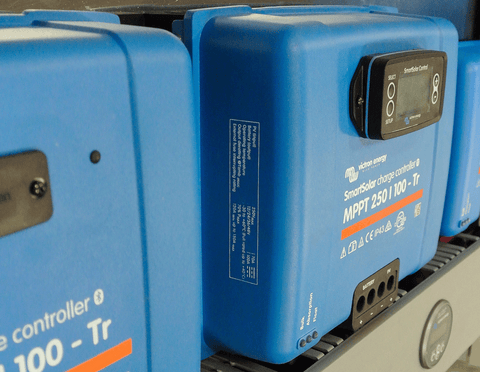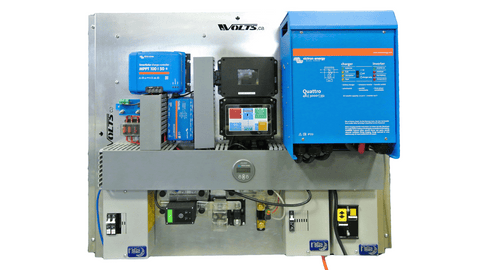How Much Does an Off-grid Solar Panel System Cost?
Publié par Armin Nalavi le
How Much Does an Off-grid Panneau solaire System Cost?
Considering the initial cost of adding solar panels to your home, getting solar panel systems in Canada can sometimes be overwhelming.
This article will discuss all possible charges you might encounter while designing and installing a solar power system. We will explain each step and the costs associated with them while building the solar panel system.

1- Cost of Solar arrays and accessories
Estimated Cost: CAD 3000 to 4200
While designing a system for solar energy systems, solar panels are the first item that comes to mind. The cost of solar panels heavily depends on your system's required output. The national average for solar power is around 4 kWh. And to reach this 4000 Wh production, you just need to divide the total energy by the power of each solar panel.
For example, you will need ten Canadian Solar 400W solar panels to produce 2 kWh from your solar arrays, which will cost you around CAD 3000 - CAD 4000.
After getting solar panels, you will need solar racking and mounting structures, which can cost anywhere from $500 - $1000 if installed on the ground or roofs. You can also use the pole mounting structures for your solar arrays, which will be more costly; however, the pole mounts have proven to be much more efficient and much easier to clean.
At last, there is the charge for the solar cables, breakers and fuse boxes, that cost around $800. We usually recommend the Midnite solar MNPV6-250 to protect panels with the included breakers and cut-off switch that is more cost-effective in solar panel installations.

2- Solar Charge controllers
Estimated Cost: CAD 1250

Charge Controllers are what make the panels work, so you can say that getting a suitable solar charge controller is almost as important as the panels themself.
The charge controllers are what make your solar panels functional, and it’s the charge controller that will regulate and adjust the voltage from solar panels while charging the batteries.

In this example, for five 400W panels, the Victron Energy 250/100 MPPT charge controller with 250V max input and 100 Amps of output would be a great match.
3- Inverter/Chargers and Inverter Cables
Estimated Cost: CAD 2250

Almost all Off-grid and grid-ties solar panel systems use an Inverter/Charger to primarily convert the DC current to usable AC for appliances. And also to charge the battery banks using the grid connection or the external generator.
In this system, as we will be dealing with 24V battery storage, the Inverter/Charger will also be 24V with a maximum power of 3000W determined by the system energy usage.

Furthermore, the Victron Energy Multiplus 24V/3000W/70-50A is designed to charge the battery bank at a maximum rate of 70 amps, making getting a suitable inverter cable critical to handle this current and voltage.
On another note, since this inverter charger will be used in a residential place, it is mandated by law to be UL 1741 certified.
4- Battery Bank
Estimated Cost: CAD 12000
Battery banks are usually the most expensive part of off-grid solar panel systems. On the other hand, a battery bank in a grid solar system costs less as they are not as crucial, and the net metering usage is much more common in these systems.

To power your home at all times with solar panels in Canada is an impossible task. And as solar panel production is often more than electricity usage on sunny days, a battery bank system will help you save the excess energy throughout the day and use them at times of need.
The debate of getting lead acid or lithium is a choice of considering many factors such as long-term or short-term usage.
In this scenario, we use three second-life tesla lithium batteries. The Tesla battery bank will be able to provide 15.3 kWh of power with 24V output and will last for more than 12 years, which is four times more than any lead-acid battery.

Also, keep in mind that even though the average costs of getting lithium batteries are higher in the beginning, in 20-25 years, with replacing the lead-acid battery bank every four years and maintenance costs, both battery banks will cost roughly the same.
5 - Accessories and Battery monitoring systems.
Estimated Cost: CAD 800

Once the batteries are determined, some other equipment such as Smart Shunt and battery BMV for monitoring battery status are often installed on the electrical system.
In addition to the relays, battery protects, and breakers, we recommend getting a Victron Energy Lynx distributor.

The Lynx Distributor is a modular DC bus bar with locations for four DC fuses. It will monitor the status of each fuse and indicate its condition with a LED on the front.
6) Monitoring System
Estimated Cost: CAD 400 - CAD 900

A monitoring system might not seem as critical as the other parts we discussed; however, with an effective monitoring system, you can extend your system’s lifetime by many years.
Furthermore, a monitoring system will save you thousands of dollars in troubleshooting any possible problems in your system. Or it will allow you to see the production of solar panels, input and output of battery banks and your usage.
Here at Volts Energies, we offer lifetime support for your system, using the same monitoring systems we recommend. This system will enable us to see states and historical data to provide the most accurate support in times of need.
A good monitoring system will include a CERBO GX and its touch monitor. Or you can use the Venus GX system, which can provide similar functions without any external displays.
Other than viewing your system while it is working, the GX system will allow you to communicate and talk to your system components while working in harmony.

7- Other Costs
Estimated Cost: CAD 500

In the end, it is always better to be safe than sorry. In order to prevent a malfunction in any component, we always install safety features between every two connections.
These Mega Fuses, Solar and Battery Breakers, Relays, and battery protects will keep everything safe from power surges, malfunctions and any other thing that might happen along the way.
Total Cost
Finally, a system that will last many years for you can cost around $20,000 to $25,000
It is also essential to consider that every system is unique and should be tailored to your needs; however, now you have an idea of what to expect while building a high-quality design.
Disclaimer
The content of this page is intended for informational purposes, and any system designed or installed will require further supervision of experts and engineers.
Partager ce message
← Message plus ancien Message plus récent →
